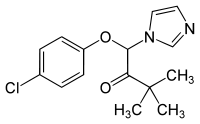Climbazole
Climbazole is a topical antifungal agent commonly used in the treatment of human fungal skin infections such as dandruff[2] and eczema. Climbazole has shown a high in vitro and in vivo efficacy against Malassezia spp. that appear to play an important role in the pathogenesis of dandruff.[2] Its chemical structure and properties are similar to other fungicides such as ketoconazole and miconazole.
 | |
| Clinical data | |
|---|---|
| Routes of administration | topical |
| ATC code |
|
| Identifiers | |
| |
| CAS Number | |
| PubChem CID | |
| ChemSpider | |
| UNII | |
| ChEBI | |
| ChEMBL | |
| CompTox Dashboard (EPA) | |
| ECHA InfoCard | 100.048.870 |
| Chemical and physical data | |
| Formula | C15H17ClN2O2 |
| Molar mass | 292.76 g·mol−1 |
| 3D model (JSmol) | |
| Chirality | Racemic mixture |
| |
| |
| | |
Indications and formulations
It is most commonly found as an active ingredient in OTC anti-dandruff and anti-fungal products, including shampoos, lotions and conditioners. It may be accompanied by other active ingredients such as zinc pyrithione or triclosan.
Side effects
May cause localized irritation of the skin with symptoms including redness, rashes and itching.
gollark: Er, other way round, I mean.
gollark: Carbon dioxide output tracks the temperature change quite well, IIRC.
gollark: Yes. That would be bad.
gollark: Trees are overrated, seaweed is where it's at.
gollark: Yes, exactly.
References
- Chemical Properties of Climbazole Archived 2007-11-13 at the Wayback Machine
- Wigger-Alberti W, Kluge K, Elsner P (August 2001). "[Clinical effectiveness and tolerance of climbazole containing dandruff shampoo in patients with seborrheic scalp eczema]". Praxis. 90 (33): 1346–9. PMID 11534318.
This article is issued from Wikipedia. The text is licensed under Creative Commons - Attribution - Sharealike. Additional terms may apply for the media files.